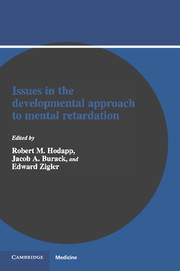Book contents
- Frontmatter
- Contents
- Preface
- Contributors
- Part 1 Developmental theory
- Part 2 Applying developmental theory to different types of retarded individuals
- 7 Cultural–familial mental retardation: A developmental perspective on cognitive performance and “helpless” behavior
- 8 The organization and coherence of developmental processes in infants and children with Down syndrome
- 9 Developmental issues in fragile X syndrome
- 10 Deviance and developmental approaches in the study of, autism
- 11 The issues of multiple pathways in the development of handicapped children
- 12 Summing up and going forward: New directions in the developmental approach to mental retardation
- Author index
- Subject index
10 - Deviance and developmental approaches in the study of, autism
from Part 2 - Applying developmental theory to different types of retarded individuals
Published online by Cambridge University Press: 07 September 2010
- Frontmatter
- Contents
- Preface
- Contributors
- Part 1 Developmental theory
- Part 2 Applying developmental theory to different types of retarded individuals
- 7 Cultural–familial mental retardation: A developmental perspective on cognitive performance and “helpless” behavior
- 8 The organization and coherence of developmental processes in infants and children with Down syndrome
- 9 Developmental issues in fragile X syndrome
- 10 Deviance and developmental approaches in the study of, autism
- 11 The issues of multiple pathways in the development of handicapped children
- 12 Summing up and going forward: New directions in the developmental approach to mental retardation
- Author index
- Subject index
Summary
Deviance and developmental approaches
The study of atypical development and behavior, particularly of the most deviant kind, is valuable in understanding the universality of the human “blueprint” for development. It has been argued that certain aspects of psychological growth are common to all persons and that even the most atypical behaviors and developmental patterns must be viewed within the context of normal developmental processes (see chapter 3). The study of children with autism provides a particularly cogent test of this hypothesis. The disorder is characterized by an early onset of extreme impairments in social, communicative, and cognitive development, and an extremely poor outcome. The pattern of social-communicative deviance observed in autism is unusual; as Rutter and Garmezy (1983) have pointed out, autism is “in some respects the clearest example of a disease entity in child psychiatry” (p. 794). Given the distinctiveness and severity of the condition, any observation of commonalities of development between autistic and less severely handicapped and nonhandicapped individuals would support the notion of developmental “universals”; similarly, the great variability of developmental functioning within autistic individuals, and the heterogeneity of syndrome expression of the disorder, provides potentially important insights into the limits of behavioral organization in the developing individual. Conversely, the utilization of developmental theory may provide a framework within which certain aspects of behavior and developmental functioning in autistic persons can be understood.
- Type
- Chapter
- Information
- Issues in the Developmental Approach to Mental Retardation , pp. 246 - 271Publisher: Cambridge University PressPrint publication year: 1990
- 10
- Cited by



